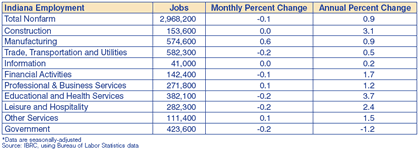Monthly Metrics: Indiana's Economic and Workforce Indicators
Regular Unemployment Claims, 2004 to 2005*
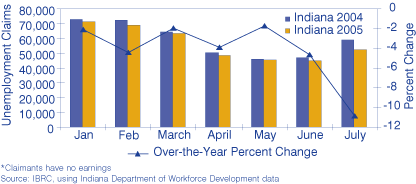
Unemployment claims for the first half of the year have been lower than the previous year. July experienced the greatest decline in the number of claims being filed—a decline of 10.9 percent (- 6,391).
Over-the-Year Unemployment Rate Percentage Point Change by City, July 2005
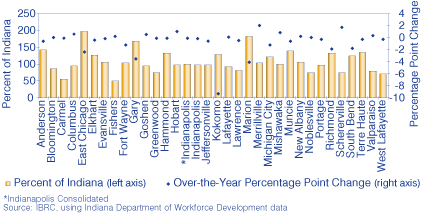
Two cities in Lake County, East Chicago and Gary, had unemployment rates well above the state rate of 5.2 percent. The city of Marion in Grant County also had a rate significantly above the state. However, all three of these cities experienced a decline in the rate over the year. The city of Marion had the greatest percentage point decline (4.1 percentage points). In fact, of the 34 cities and towns, only 10 showed an increase over the year. Merrillville showed the largest over-the-year (OTY) percentage point increase (2.0), and Schererville showed the largest percent increase, although Schererville still remains a full 1.3 percentage points below the state. The decline in the Kokomo rate is due to manufacturing plant shutdowns last year.
Employment, 2005*
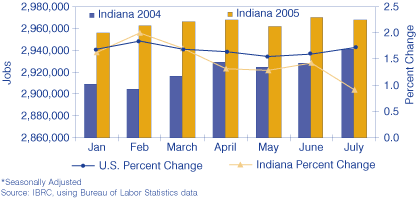
For the first half of 2005, the state significantly expanded jobs over the previous year; now, however, the expansion has tapered off a bit. Indiana closely tracked the nation in the rate of expansion in the first quarter but is now adding jobs at a slower rate than the United States.
Manufacturing Employment, 2005*
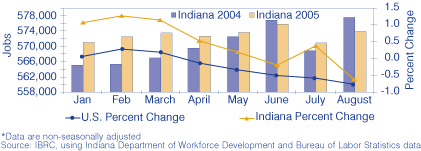
Manufacturing jobs have increased almost every month for the first half of 2005. In May and July, the nation contracted and lost manufacturing jobs, while Indiana has expanded (most notably in July). However, Indiana’s rate of expansion has slowed as the year has progressed, falling more in line with the nation.
Manufacturing Earnings, 2005

For the majority of 2005, Indiana’s manufacturing earnings were lower than the previous year’s earnings. However, the state has seen a reversal in July and August. Where Indiana’s manufacturing earnings declined through June 2005, the United States has experienced increases. Even so, Indiana manufacturing workers still enjoy higher wages than other manufacturing workers throughout the nation. In August, a typical Indiana worker in the manufacturing industry earned $100 more per week than a worker outside of the state.
Indiana Employment by Major Sector, July 2005*
Trade, transportation and utilities was the leading Indiana sector in terms of number of jobs in 2005, followed closely by manufacturing. The educational and health services industry experienced the most growth over the year, while government employment decreased 1.2 percent.
Residential Building Permits Issued, 2004 to 2005
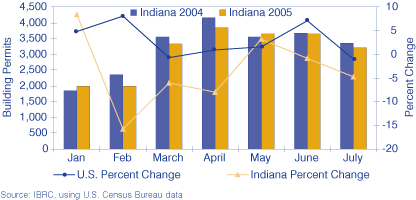
The Indiana housing market has cooled off a bit since last year, while the nation continues to show healthy gains in the number of building permits being issued.
Biomedical/Biotechnical Change in Jobs and Average Weekly Wages, Fourth Quarter
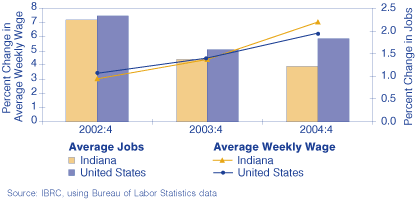
Indiana continues to add jobs in the biomedical/biotechnology cluster at a slower rate than the nation, a gap that widened in 2004. Indiana tracks the nation very closely in average weekly wages. Overall, Indiana has added 234 businesses and 4,400 jobs over the year.

